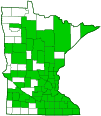Dryad’s Saddle
(Cerioporus squamosus)
Conservation • Description • Habitat • Ecology • Distribution • Taxonomy
Conservation Status |
|||
| IUCN Red List | not listed |
||
| NatureServe | not listed |
||
| Minnesota | not listed |
||
Description |
Dryad’s Saddle, also called Pheasant’s Back Polypore, is a common, easily recognized, wood decaying, bracket fungus. It fruits mostly in the spring but occasionally also in the summer or fall. It is found usually in overlapping clusters of 2 or 3, sometimes singly. It is both saprobic, occurring on logs and stumps of dead hardwood trees, and parasitic, occurring on the lower trunk of living hardwood trees, especially elms. The fruiting body is a large, stalked bracket. The bracket is circular to fan-shaped or kidney-shaped, 2¼″ to 12″ in diameter, and up to 1½″ thick. The upper surface is light yellowish-brown with flat, brown or dark brown scales. The scales have a feathery appearance, which accounts for the common names Hawk’s Wing and Pheasant’s Back. In the fall, if the bracket survives that long, it can look very different. The scales are washed away and the bracket is white with a reddish-black center. The underside is whitish. The pores are small at first, becoming very large, up to ⅜″ in the largest dimension. The stalk (stipe) is short, thick, tough, and often off-center. It is 1¼″ to 4″ long and ¾″ to 2¼″ in diameter. As it ages the base of the stipe becomes velvety black. The flesh is white. The spores are whitish to cream-colored. |
Similar Species |
Habitat and Hosts |
Hardwood and mixed forests. Dead and living hardwoods, especially elm. |
Ecology |
Season |
Spring |
Distribution |
||
|
Sources Biodiversity occurrence data published by: Minnesota Biodiversity Atlas (accessed through the Minnesota Biodiversity Atlas Portal, bellatlas.umn.edu, 8/26/2025). |
|
| 8/26/2025 | ||
Occurrence |
||
Common |
||
Taxonomy |
|
Kingdom |
Fungi (Fungi) |
Subkingdom |
Dikarya |
Phylum |
Basidiomycota (Basidiomycete Fungi) |
Subphylum |
Agaricomycotina (Higher Basidiomycetes) |
Class |
Agaricomycetes (Mushrooms, Bracket Fungi, Puffballs, and Allies) |
Subclass |
Agaricomycetidae |
Order |
Polyporales (shelf fungi) |
Family |
Polyporaceae (bracket fungi) |
Genus |
Cerioporus |
Genus |
|
Subordinate Taxa |
|
|
|
Synonyms |
|
Agarico-pulpa ulmi Boletus cellulosus Boletus juglandis Boletus maximus Boletus michelii Boletus platyporus Boletus polymorphus Boletus squamosus Boletus testaceus Bresadolia caucasica Bresadolia paradoxa Bresadolia squamosa Cerioporus michelii Cerioporus rostkowii Favolus squamosus Heteroporus biennis var. flabelliformis Leucoporus lepidus Melanopus squamosus Polyporellus rostkowii Polyporellus squamatus Polyporellus squamosus Polyporellus squamosus ssp. granulisquamosus Polyporellus squamosus ssp. rostkowii Polyporus alpinus Polyporus biennis var. flabelliformis Polyporus clusianus Polyporus dissectus Polyporus flabelliformis Polyporus flabelliformis ssp. flabelliformis Polyporus flabelliformis ssp. tigrinus Polyporus infundibiliformis Polyporus infundibuliformis Polyporus juglandis Polyporus juglandis ssp. juglandis Polyporus juglandis var. pictus Polyporus juglandis var. rangiferinus Polyporus michelii Polyporus pallidus Polyporus retirugis Polyporus retirugus Polyporus rostkowii Polyporus squamatus Polyporus squamosus Polyporus squamosus ssp. maculatus Polyporus squamosus ssp. michelii Polyporus squamosus ssp. polymorphus Polyporus squamosus ssp. rostkowii Polyporus squamosus var. crassipes Polyporus squamosus var. glaber Polyporus squamosus var. levipes Polyporus squamosus var. maculatus Polyporus squamosus var. maximus Polyporus squamosus var. polymorphus Polyporus tigrin Polyporus ulmi Polyporus westii Scenidium pallidum Trametes retirugis Trametes retirugus |
|
Common Names |
|
Dryad’s Saddle Hawk’s Wing Pheasant’s Back Mushroom Pheasant’s Back Polypore |
|
Glossary
Saprobic
A term often used for saprotrophic fungi. Referring to fungi that obtain their nutrients from decayed organic matter.
Stipe
A supporting stalk-like structure lacking vascular tissue: in fungi, the stalk supporting the mushroom cap; in ferns, the stalk connecting the blade to the rhizome; in flowering plants, the stalk connecting the flower’s ovary to the receptacle; in orchids; the band connecting the pollina with the viscidium.
Visitor Photos |
Share your photo of this fungus. |
||
This button not working for you? |
||
Amy Stifter |
 |
Big mushroom Saw this on Medicine Lake Regional trail near Vicksburg and Bass Lake Rd. At least 10” across. |
Luciearl |
 |
Kirk Nelson |
||
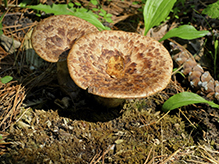 |
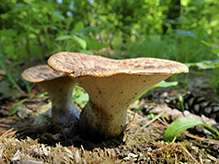 |
|
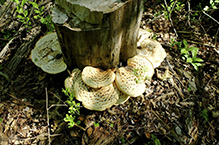 |
||
Margot Avey |
||
I took these photos this morning at Westwood Nature Center, St Louis Park MN. It is a fabulous place to walk and enjoy nature up close! |
||
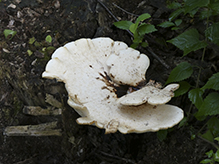 |
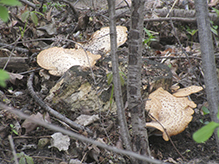 |
|
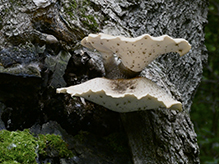 |
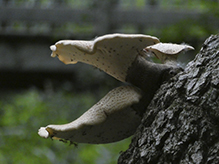 |
|
Cary Schmies |
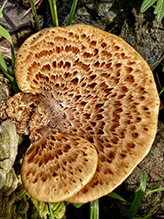 |
looks like bird feathers |
Alfredo Colon |
 |
James |
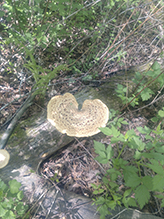 |
L. Bessel |
||
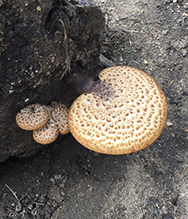 |
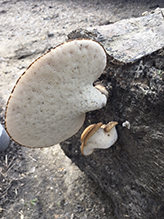 |
|
Steve B |
||
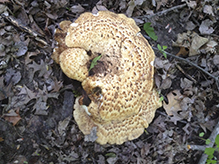 |
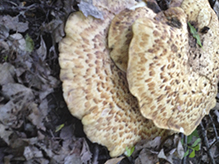 |
|
MinnesotaSeasons.com Photos |
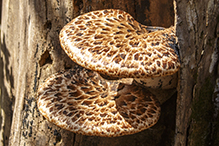 |
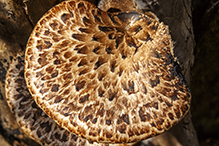 |
|
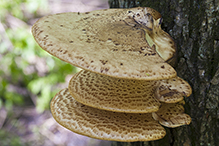 |
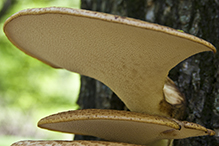 |
|
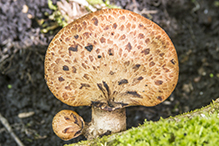 |

Slideshows |
Dryad Saddle |
About
Cerioporus squamosus |
Cerioporus squamosus |
About
Published on May 29, 2013 Un champignon trouvé sur une souche dans le jardin. J'ai créé cette vidéo à l'aide de l'outil de création de diaporamas YouTube (http://www.youtube.com/upload). |

Visitor Videos |
Share your video of this fungus. |
||
This button not working for you? |
||
|
Other Videos |
Dryad Saddle Mushroom |
About
Uploaded on May 15, 2011 Cerioporus squamosus is a spring time wild edible mushroom that is found in the same habitat and at the same time of year as morel mushrooms here in Southern Michigan. |
Super Huge Fungus - Dryad’s Saddle (Cerioporus squamosus) on a tree |
About
Uploaded on Jul 14, 2011 Awesome example of large tree fungus on a sycamore tree. Name is Dryad’s Saddle (Cerioporus squamosus) and it is edible when younger. Thanks to 'grifola' for that information. |
Pheasantback Mushroom (Cerioporus squamosus) |
About
Published on May 20, 2013 I found mushrooms today, I was pretty sure they were Pheasantback or Dryad’s saddle but wasn't 100% sure till I put this video up so I didn't bring them home, my research says you should always pick them small, large ones are rubbery! and they have a faint smell of watermellon. |

Visitor Sightings |
Report a sighting of this fungus. |
||
This button not working for you? |
||
Amy Stifter |
Location: Medicine Lake Regional Trail Saw this on Medicine Lake Regional trail near Vicksburg and Bass Lake Rd. At least 10” across. |
 |
| Luciearl 8/4/2024 |
Location: Lake Shore, MN |
 |
Darlene Thomas |
Location: Lake Plantagenet, Bemidji, MN |
| Margot Avey 8/27/2022 |
Location: Westwood Nature Center, St Louis Park MN |
 |
| Margot Avey 7/18/2022 |
Location: Westwood Nature Center, St Louis Park MN |
 |
| Cary Schmies 6/17/2022 |
Location: St. Louis County looks like bird feathers |
 |
| Margot Avey 5/17/2022 |
Location: St. Louis Park, MN |
 |
Apricity Apricity |
Location: Martin County, Fairmont, MN |
| Alfredo Colon 8/4/2019 |
Location: Woodbury, MN |
 |
| Brian 8/2/2018 |
Location: Theodore Wirth Park, Minneapolis, MN Huge white Dryad’s Saddles 40 cm+ growing on old downed elm tree |
| James 5/18/2018 |
Location: MN |
 |
| L. Bessel 8/28/2017 |
Location: Sibley County |
 |
| Steve B 5/22/2017 |
Location: Plymouth/Hennepin |
 |
| Kirk Nelson 5/15/2016 |
Location: Lebanon Hills Regional Park |
 |
MinnesotaSeasons.com Sightings |

|
Created: 5/29/2013 Last Updated: © MinnesotaSeasons.com. All rights reserved. |
